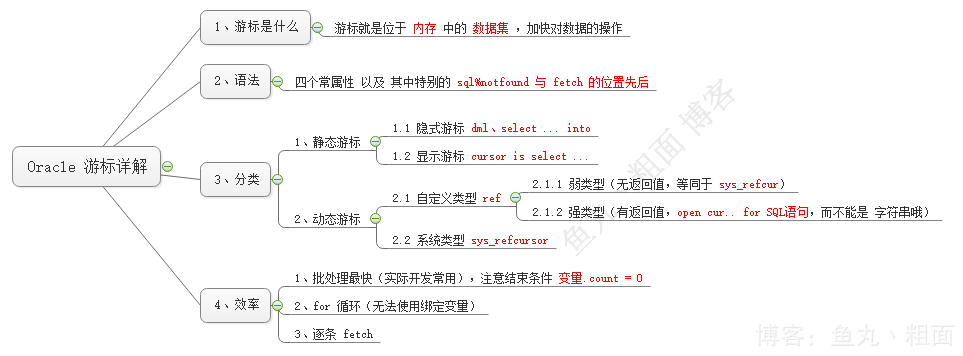Oracle数据库的游标和for循环使用
1. 游标的概念和作用
- 游标是 sql 的一个内存工作区,由系统或用户以变量的形式定义
- 游标的作用就是用于临时存储从数据库中提取的数据块(结果集)。
- 它有一个
指针,从上往下移动(fetch),从而能够遍历每条记录。 - 用
牺牲内存来提升 SQL 执行效率,适用于 大数据处理。
(摘抄自https://blog.csdn.net/qq_34745941/java/article/details/81294166)。
2.游标结构图

3.具体用法
游标有四大属性,分别是
1. “SQL%ISOPEN” :布尔类型。判断游标是否打开
2.“SQL%FOUND”:布尔类型。判断上一条fetch语句是否有值,有则为true,否则为false;
3.“SQL%NOTFOUND”:布尔类型。与2相反,常用作退出循环的条件。
4.“SQL%ROWCOUNT”:整型。当前成功执行更改的数据行数。
3.1 静态游标
3.1.1 隐式游标
使用DML操作(增删改)或select……into……会自动创建隐式游标,名称是“sql”,该游标会自动声明,打开和关闭。无需人为开启或关闭。
create or replace procedure ATest( O_Result Out VarChar2 )is v_id staff.id%type; begin insert into staff(id,name) values(1,'张三'); if sql%found then O_Result:='添加成功'; end if; update staff set name = '李四'where id = 1; if sql%found then O_Result:='更新成功'; end if; delete from staff where id = 1; if sql%found then O_Result:='删除成功'; end if; select id into v_id from staff; if sql%found then O_Result:='查询成功'; end if; if sql%isopen then O_Result:='游标为开启状态,但不可能走到这一步'; --游标只有在执行上述增删改操作才会开启并自动关闭 else O_Result:='游标为关闭状态'; end if; exception when Others then begin O_Result:='N_SQLCODE is '||SQLCODE||' and SQLERRM is '||SQLERRM; rollback; end; end;
3.1.2 显式游标
显示游标又分为不带参数和带参数两种
无参:
create or replace procedure ATest( O_Result Out VarChar2 )is v_cur_info staff%rowtype; cursor v_cur is --声明游标 为staff表的数据集 select * from staff; begin open v_cur; --打开游标 fetch v_cur into v_cur_info; --赋值给游标 O_Result:='ID:'||v_cur_info.id||',Name:'||v_cur_info.name;--输出值 close v_cur; --关闭游标 exception when Others then begin O_Result:='N_SQLCODE is '||SQLCODE||' and SQLERRM is '||SQLERRM; rollback; end; end;
输出结果: ID:1,Name:张三
带参:
create or replace procedure ATest( O_Result Out VarChar2 )is v_cur_info staff%rowtype; cursor v_cur(v_id staff.id%type) is --声明游标 为staff表的数据集 select * from staff where id =v_id; --参数:v_id begin open v_cur(1); --打开游标 fetch v_cur into v_cur_info; --赋值给游标 O_Result:='ID:'||v_cur_info.id||',Name:'||v_cur_info.name; close v_cur; --关闭游标 exception when Others then begin O_Result:='N_SQLCODE is '||SQLCODE||' and SQLERRM is '||SQLERRM; rollback; end; end;
输出结果: ID:1,Name:张三
3.2 动态游标
3.2.1 自定义类型游标
自定义游标类型声明写法:
TYPE ref_type_name IS REF CURSOR [RETURN return_type];
ref_type_name代表我们自定义类型的名称,cursor是系统默认的
return_type代表数据库表中的一行,或一个记录类型,是一个返回类型;
返回值不是必要的,无返回值则称为弱类型,更加灵活;有返回值称为强类型,减少错误;
弱类型写法:
create or replace procedure ATest( O_Result Out VarChar2 )is v_cur_info staff%rowtype; type v_cur_type is ref cursor; --自定义游标类型 v_cur v_cur_type; begin open v_cur for --打开游标并声明 select * from staff where id<5; loop --开始循环 fetch v_cur into v_cur_info; -- 赋值 exit when v_cur%notfound; --判断没有值就退出循环 O_Result:= O_Result||chr(10)|| 'ID:'||v_cur_info.id||',Name:'||v_cur_info.name; end loop; close v_cur; exception when Others then begin O_Result:='N_SQLCODE is '||SQLCODE||' and SQLERRM is '||SQLERRM; rollback; end; end;
另一种写法:
create or replace procedure ATest( O_Result Out VarChar2 )is v_sql varchar(1000); v_param staff.id%type:=5; v_cur_info staff%rowtype; type v_cur_type is ref cursor; --自定义游标类型 v_cur v_cur_type; begin v_sql:='select * from staff where id <:id'; open v_cur for v_sql --打开游标并声明 using v_param; --绑定参数方法 loop --开始循环 fetch v_cur into v_cur_info; -- 赋值 exit when v_cur%notfound; --判断没有值就退出循环 O_Result:= O_Result||chr(10)|| 'ID:'||v_cur_info.id||',Name:'||v_cur_info.name; end loop; close v_cur; exception when Others then begin O_Result:='N_SQLCODE is '||SQLCODE||' and SQLERRM is '||SQLERRM; rollback; end; end;
强类型写法:
三个注意事项:
1.强类型无法使用绑定参数方法
2.for后面必须是sql,不能是字符串,如上面的v_sql;
3.参数必须对应;
create or replace procedure ATest( O_Result Out VarChar2 )is v_cur_info staff%rowtype; type v_cur_type is ref cursor return staff%rowtype ; --自定义游标类型 v_cur v_cur_type; begin open v_cur for --打开游标并声明 select * from staff where id <5; loop --开始循环 fetch v_cur into v_cur_info; -- 赋值 exit when v_cur%notfound; --判断没有值就退出循环 O_Result:= O_Result||chr(10)|| 'ID:'||v_cur_info.id||',Name:'||v_cur_info.name; end loop; close v_cur; exception when Others then begin O_Result:='N_SQLCODE is '||SQLCODE||' and SQLERRM is '||SQLERRM; rollback; end; end;
3.2.2 系统类型游标
简写手动声明自定义游标的过程
type v_cur_type is ref cursor return staff%rowtype ; --自定义游标类型
v_cur v_cur_type;
等同于 v_cur sys_refcursor;
4.效率问题
没有实际测试过,根据其他博客总结是这样:一般来说批量处理的速度要最好,隐式游标的次之,单条处理的最差
以下是示例:
1、批量处理 open 游标; loop fetch 游标 bulk collect into 集合变量(也就是 table 类型哦) limit 数值; -- 一般 500 左右 exit when 条件 --(变量.count = 0,如果用 sql%notfound 不足 limit 的记录就不会被执行哦) close 游标; 2、隐式游标 for x in (sql 语句) loop ... 逻辑处理 end loop; 3、单条处理 open 游标; loop fetch 游标 into 变量; exit when 条件 end loop; close 游标; ———————————————— 原文链接:https://blog.csdn.net/qq_34745941/java/article/details/81294166
批量处理的关键字不是很了解,下次学习下在记录起来;
隐式游标写法最简洁明了,类似于程序中的for循环写法;
单条处理大概就是上面那些范例的写法。
(如果有错误,再回来改正)。
内容参考于https://blog.csdn.net/qq_34745941/article/details/81294166和
https://www.cnblogs.com/heshan664754022/archive/2013/05/22/3092437.html
------------恢复内容结束------------



